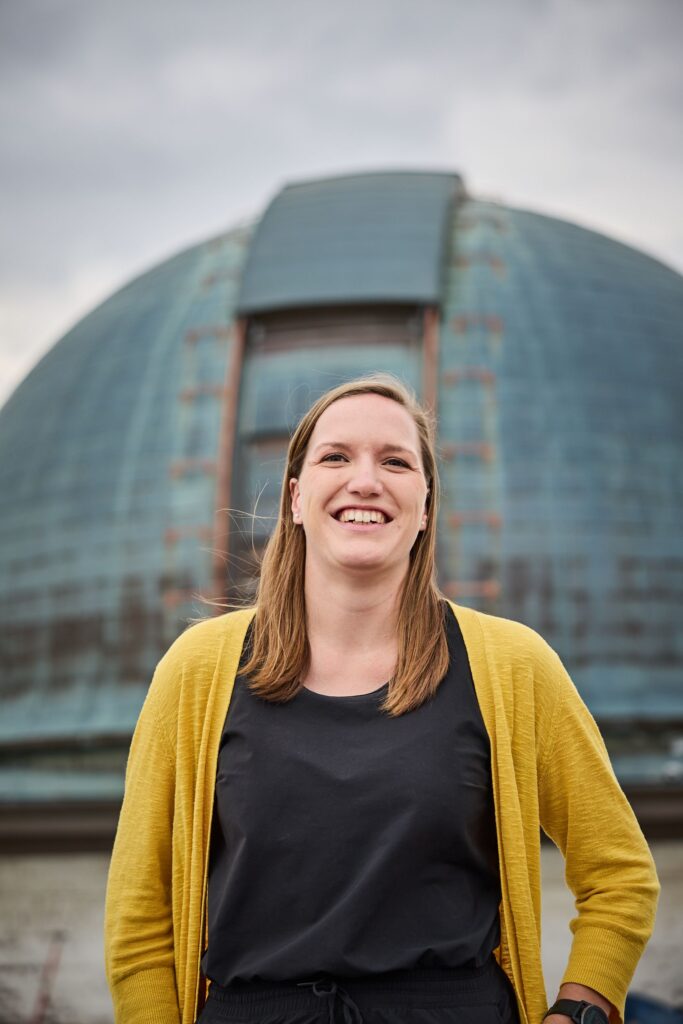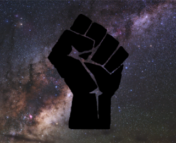By Floor Broekgaarden. This piece is being cross-posted from Bulletin of the AAS (BAAS). The BAAS post can be found here.

Floor Broekgaarden just finished her Ph.D. at Harvard University and is an incoming Junior Fellow in the Simons Society of Fellows in New York, for which she is hosted at Columbia University, the Computational Center for Astrophysics (CCA), and the Simons Foundation. Her research focuses on Gravitational Wave Paleontology: studying massive stars from their ‘remnants’ as compact object coalescences, with the goal to answer some of the key questions in gravitational-wave astronomy today: How do these gravitational-wave sources form? What can we learn from them about the formation, lives, and explosive deaths of massive stars across cosmic time?
Many astronomers experience workplace incivility including bullying, (sexual) harassment, or racism in their career (either as target or witness). Finding support to navigate such situations is important, yet challenging, especially for early-career astronomers or underrepresented minorities. This contributes to the structural exclusion of those that experience or witness workplace incivility from our astronomy community. Here I suggest ten ways that departments, institutes, collaborations, and conference organizers can improve support for astronomers that experience or witness incivility.
A story
I want to share Susan’s story. Although this story is derived from the experiences of one individual, her story is not unique nor is it bound to one institution or organization.
Susan was a straight-A, ambitious college student who always dreamed of becoming an astronomer. She was absolutely thrilled when she was admitted to and began a PhD program in Astrophysics at a top US school. These feelings changed quickly. During her PhD, Susan witnessed and experienced harassment and bullying, and was terrified of navigating the situation. She was encouraged to trust a professor with her experiences, and engaged in several conversations about them with that professor. Her worst fears came true when that same professor broke their promised confidentiality and shared Susan’s experiences non-anonymously with the harasser and other professors without her consent or prior knowledge. Susan only found out as the faculty members eventually approached her and mentioned it, each time much to her disbelief.
Navigating harassment is challenging no matter the circumstances, but having her concerns shared without her knowledge by those who were supposed to support her was paralyzing. It shattered her trust. As months passed, Susan felt increasingly unwelcome each day she stepped into her department. She stopped enjoying her research, stopped attending social and scientific events, and dropped one of her favorite classes. One day, at the end of an international conference, a professor approached her to share that he had heard she had reported someone. Susan was so anxious about how much the situation had escalated out of her control that she was ready to drop out and quit her Ph.D.
As a last resort, Susan reached out to external resources. They sat down with her and for the first time, asked Susan the question: “How can we support you?” After helping Susan devise a plan to resolve the situation, they organized a meeting with everyone involved. In this meeting, Susan shared her concerns about the process and support she had received (and lacked), which took significant courage to share in a room with so many people who held power over her future career. She told them what support she needed and suggested ways the situation could be resolved. They followed her lead, and within a few weeks, the situation was resolved to everyone’s satisfaction. Moreover, during the conversations, they discovered shared values about improving the department together. With their support, Susan helped create better departmental resources, implement a code of conduct, and organize training and workshops for their institute. Fast-forward four semesters, and Susan is once again a thriving straight-A student. She is winning prestigious Ph.D. scholarships, graduating early, and receiving some of the most sought-after job offers.
Now let’s look at the data. Harassment in astronomy is common: studies report numbers between 15%–60% of students or employees experience harassment and discrimination at school or work [1][2][3][4], and the numbers are typically worse for multiple marginalized persons such as LGBTQPAN women and gender minorities and/or women of color [5][6][7]. However, the majority of astronomers do not know where to go for help and support when harassment occurs [2][4]. This contributes to the structural exclusion of those who experience or witness harassment from our community, not because they cannot keep up with coursework or research, but because they cannot find the life-changing support needed to navigate situations concerning harassment.
In astronomy, we claim our passion and purpose is to help people be their best, to help them be successful. Yet, we are hardly providing our best anti-harassment services by focusing on formal reporting processes that do not center on transparency, privacy, or the perspective of the victim, which pushes victims out of the field. We can and must do better. There are more Susans out there, and many who were not fortunate enough to receive the support Susan was afforded. Without this support, Susan would have never made it through her Ph.D. program. And I would know because Susan is me.***
How can we improve? Ten suggestions:
Below are ten suggestions for improvement. Many recommendations are based on those from the American Astronomical Society Committee on the Status of Women in Astronomy (CSWA) survey [8] and the Astronomy Decadal Survey [9].
- Implement a public code of ethics or code of conduct [10][2]. A code of conduct helps community members recognize what constitutes harassment, discrimination, bullying, and other forms of misconduct. They foster a culture of safety and inclusion by explicitly setting a framework for what a welcoming workplace climate entails. Personally, it is the first thing I look for when I experience uncomfortable behavior. A good code of conduct includes clear language explaining what constitutes appropriate professional behavior. It is recommended that every department, collaboration and/or organization drafts a code of conduct and makes people aware of its existence on a regular basis, e.g., during introductions or at an annual meeting. The AAS provides an example code-of-ethics here: https://aas.org/policies/ethics.
- Designate point persons for harassment concerns. It can be challenging for astronomers to know whom to talk to, especially when harassment happens in a collaboration/group they work with. Having a point person provides a resource for community members, as the point person offers a listening ear and can help with next steps. It is helpful if the available point persons are listed (including how to reach out to them) on a public website and introduced at an annual meeting. External point persons are available for all astronomers, namely the Astronomy Allies and, in the US, the AAS’s EthicsPoint service.
- Provide adequate training for the persons entrusted to deal with code-of-conduct concerns. In particular, provide training on privacy and resources for point persons to consult when the situation requires professional input. Connect point persons to the local professionally trained Title IX and/or ombudspersons to provide resources and support for navigating more challenging situations that would benefit from the knowledge and experience of trained experts.
- When concerns are brought forward, “instigators should be swiftly, justly, and consistently sanctioned” as this signals to the broader community that harassment is not tolerated [10]. Even if the investigation takes longer, other actions can happen on a shorter timescale such as organizing department-wide harassment, bystander, and awareness training or simply sending a reminder of the code of conduct.
- Organize diversity and cultural awareness training. This raises awareness and understanding of the problems faced by underrepresented groups [10][11]. Diversity and inclusion training can positively address biases and prejudice within organizations [12].
- Organize bystander training. Bystander training provides skills, resources, and familiarity for members of the workplace to learn how to identify, and confront potential inappropriate behavior and help create a culture of accountability [13]. Bystanders play an important role not only in establishing a culture in which harassment is not tolerated but also as change agents who can create a safe environment during and in the aftermath of incidents. An example of bystander training includes the available step-up program: http://stepupprogram.org which was created in collaboration with The University of Arizona and the NCAA.
- Move beyond legal compliance to address culture and climate [4]. Academic institutions should move beyond interventions or policies that solely rely on formal reports made by targets. Examples include organizing training and awareness initiatives to improve workplace climate and reduce or prevent sexual harassment. Astronomy institutions should also raise awareness about alternative support besides filing complaints and investigations that offices such as Title IX can provide. Typical support includes training, assistance in making campus life changes (e.g. changing offices), mediation and support in difficult conversations, and help with missed deadlines. See for example this article.
- Improve transparency and accountability [14][4]. Where possible, provide reasonable feedback to victims on the expected process and timeline. Use climate surveys to openly address community concerns. Initiate department-wide discussions, committees, and meetings to address concerns and improve workplace climate.
- Connect members to local resources. Universities often provide numerous resources to department members. Examples include unions, which often provide helpful and trained resources for students and postdocs, as well as wellness centers, mental health services, and university-wide ombudspersons.
- Avoid saying “they/I had the best intentions.” Just avoid it. It is not needed, it does not add anything, and it undermines the experience of the person reporting. See for example this article that explains why this statement often does not alleviate the harm done.
- [bonus] Learn more about the topic. There are many great resources on topics like systemic racism and women in astronomy. Many of the resources mentioned in this article provide further recommendations on reducing harassment and improving workplace climate.
As the Decadal Survey in Astronomy quotes: “The persistence of harassment and discrimination in astronomy and astrophysics is intolerable, and must not be tolerated if the astronomy and astrophysics professions are to retain and successfully draw from the full diversity of talent available, not to mention avoiding the toxic and corrosive effects that such behaviors have on individuals, organizations, and the entire profession” [9]. I hope that we can work together to improve this.
Acknowledgements
I am grateful to all readers of this manuscript. My hope is that it serves as a resource for improving harassment support and resources at your own institution. I wrote this paper with a focus on presenting a short story to help the reader understand the importance of support resources, as well as having a checklist of actionable suggestions. FSB is grateful for the suggestions on this draft from Christina Richey, Osase Omoruyi, Victoria DiTomasso, Boryana Hadzhiyska, and Matt Ashby. FSB is additionally very grateful for the Harvard GSAS Union, the AAS, Harvard Title IX, the CfA, the Harvard Ombudspersons, the CfA Code of Conduct Committee, and the IAU Executive Committee WG Women in Astronomy that helped inform and educate FSB in the past years on code-of-conduct and workplace civility best practices and resources. FSB wants to acknowledge all astronomers out there who haven’t received the support they deserve during challenging situations and all that cannot speak out about their situation. I appreciate you.
***Author’s note: The story described here has been created by mixing several different true experiences that took place at different institutes and organizations. I emphasize that the story did not exactly take place in the way it is written here and that the purpose of describing it is to give a perspective of challenges in finding support, not to point fingers at a specific institution or person(s). I strongly believe these stories are common and require community-wide efforts to improve support frameworks in academia.
More examples
Below are a few examples of earlier public stories that have emphasized the need for better support when dealing with harassment, bullying or other unprofessional behavior.
- The Serial Harasser’s Playbook, May 14, 2014
- Fed up with harassment, May 15, 2014
- Famous Astronomer allegedly harassed students, Oct 9, 2015
- Title IX Inaction in Astronomy, 12 March 2020
- Systemic Racism, June 16, 2020
- Astronomy bullying scandal 22 June 2021
- Bullying and harassment poll, July 23 2021
- UF complaint by PhD student, October 18, 2021
- Lawsuit for ignoring harassment complaints, Feb 9, 2022
- Dutch Astronomer barred, October 26, 2022
References
- Ilies R., Hauserman N., Schwochau S., Stibal J., 2003, Personnel Psychology, 56, 607
- Clancy K. B., Nelson R. G., Rutherford J. N., Hinde K., 2014, PloS one, 9, e102172
- Porter A. M., Walsh C., Ivie R., 2022, AIP Statistical Research Center
- National Academies of Sciences Engineering and Medicine et al., 2018, National Academies of Sciences Engineering and Medicine
- Clancy K. B. H., Lee K. M. N., Rodgers E. M., Richey C., 2017, Journal of Geophysical Research (Planets), 122, 1610
- Kosciw J. G., Clark C. M., Truong N. L., Zongrone A. D., 2020, The 2019 National School Climate Survey: The Experiences of Lesbian, Gay, Bisexual, Transgender, and Queer Youth in Our Nation’s Schools. A Report from GLSEN.. ERIC
- Richey C. R., Lee K. M., Rodgers E., Clancy K. B., 2020, Bulletin of the AAS, 51
- Richey C., Clancy K. B. H., Lee K. M. N., Rodgers E. M., 2021, in Bulletin of the American Astronomical Society. p. 445, doi:10.3847/25c2cfeb.fc872f69
- National Academies of Sciences, Engineering, and Medicine 2021, Pathways to Discovery in Astronomy and Astrophysics for the 2020s. The National Academies Press, Washington, DC, doi:10.17226/26141, https://nap.nationalacademies.org/catalog/26141/pathways-to-discovery-in-astronomy-and-astrophysics-for-the-2020s
- Cortina L. M., Kabat-Farr D., Leskinen E. A., Huerta M., Magley V. J., 2013, Journal of Management, 39, 1579
- National Research Council 2013, Seeking Solutions: Maximizing American Talent by Advancing Women of Color in Academia: Summary of a Conference. The National Academies Press, Washington, DC, doi:10.17226/18556, https://nap.nationalacademies.org/catalog/18556/seeking-solutions-maximizing-american-talent-by-advancing-women-of-color
- Bezrukova K., Spell C. S., Perry J. L., Jehn K. A., 2016, Psychological bulletin, 142, 1227
- Commission U. E. E. O., et al., 2019, June 2016 Report of the Co-Chairs of the Select Task Force on the Study of Harassment in the Workplace, 2016 MNRAS 000, 1–3 (2023)
- Ackerman N., Atherton T., Avalani A. R., Berven C. A., Laskar T., Neunzert A., Parno D. S., Ramsey-Musolf M., 2018, arXiv e-prints, p. arXiv:1804.08406





Ik ben zo blij dat het allemaal goed uitkwam.